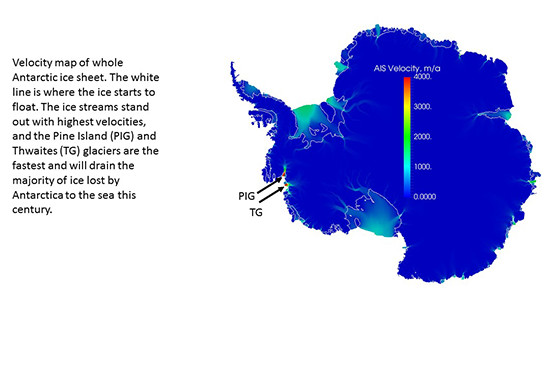In a Comment published in the journal Nature on 15 March 2018 by John C. Moore and Rupert Gladstone of the Arctic Centre, University of Lapland with colleagues from CSC – the Finnish IT Center for Science and Princeton University, USA, argue that applying targeted geoengineering to preserve the ice sheets is a topic worthy of serious research and investment in Antarctic infrastructure.
By 2100, most large coastal cities will face sea levels that are more than a metre higher than currently. For example, a 0.5-metre rise in Guangzhou, China, would displace more than 1 million people; a 2-metre rise would affect more than 2 million. Without coastal protection, the global cost of damages could reach US$50 trillion a year. Sea walls and flood defences cost tens of billions of dollars a year to construct and maintain.
The ice sheets of Greenland and Antarctica will contribute more to sea-level rise this century than any other source, stalling the fastest flows of ice into the oceans would buy us a few centuries to deal with climate change and protect coasts.
“Just a few very fast flowing glaciers in Greenland and Antarctica drain much of the ice sheets, and will be the route for ice that will raise sea levels. These glaciers are tens of kilometres across, and so attractive targets to stabilize rather than building walls around the world’s coastline”, explains John Moore, Research Professor at University of Lapland and Chief Scientist in Beijing Normal University, China.
The glaciers could be slowed in 3 ways: warm ocean waters could be prevented from reaching their bases and accelerating melting; the ice shelves where they start to float could be buttressed by building artificial islands in the sea; and the glacier beds could be dried by draining or freezing the thin film of water they slide on. “Advanced ice/ocean computer modelling helps to evaluate the effectiveness of these ideas”, says Thomas Zwinger, Application Scientist at CSC.

The engineering costs and scales of these projects are comparable with today’s large civil engineering projects, but with extra challenges due to the remote and harsh polar environment. Artificial islands have been built such as Hong Kong new airport; water is drained into rock tunnels beneath a glacier in Norway to feed a hydropower plant; raising a berm in front of the fastest flowing glacier in Greenland would need a wall only 5 km across and 100 m high.
Potential risks, especially to local ecosystems, need careful field work and computer modelling, the glaciers need their beds and melt rates mapping and improvements in climate model simulations of the Southern Ocean and the North Atlantic’s flow onto the Greenland shelf are required. In our view, however, the greatest risk is doing nothing — or if the interventions don’t work. The impacts of construction would be dwarfed locally by the effects of the ice sheet’s collapse, and globally by rapid sea-level rise. Geoengineering of glaciers will not mitigate global warming from greenhouse gases. The fate of the ice sheets will depend ultimately on how quickly we bring down emissions. If they peak soon, it should be possible to preserve the ice sheets until they are again viable. If emissions keep rising, the aim will become managing the collapse of the ice sheets to smooth the rate of sea level rise and ease adaptation.
Further information:
John Moore, University of Lapland, Arctic Centre john.moore.bnu(at)gmail.com, +358 400 194 850
Thomas Zwinger, CSC – IT center for Science, thomas.zwinger(at)csc.fi, +358 50 381 9538
John C. Moore, Rupert Gladstone, Thomas Zwinger and Michael Wolovick: Geoengineer polar glaciers to slow sea-level rise. Nature, 15 March 2018, vol 555.
LaY/AK/JM&JW